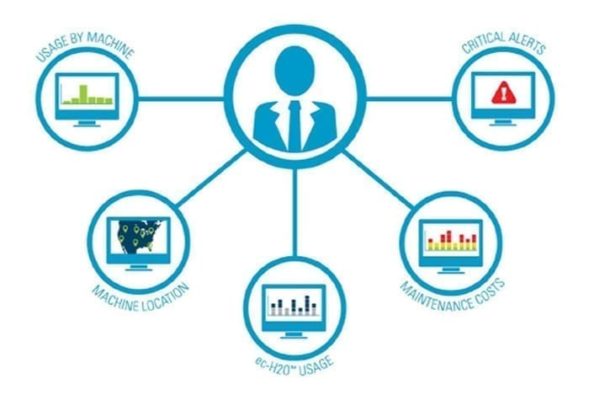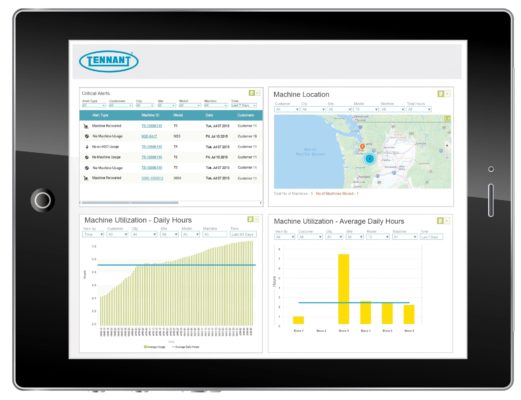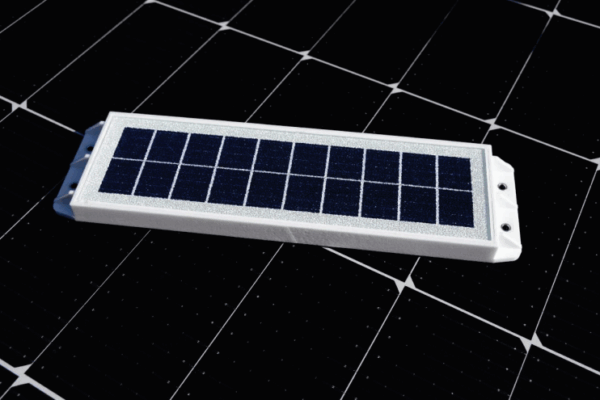
3000%
Growth beyond forecasted sales goal for the IRIS IoT-enabled solution within the first year
$1 Billion
Annual revenue with the adoption of their new IoT-lead strategy
Products and Solutions
This represents again a ten-year journey to make a scalable model bring the internet of things to life a tenant which has been enormously challenging along the way but we do see an enormous value proposition coming from it.
Paul Wellman, CIO of the Tennant Company
Lowering Customers’ Cost to Clean
Places with large floorspaces take (relatively) large machines and fleets to do the job.
Minneapolis, Minnesota based firm Tennant is a world leader in the marketing, sales, and service of industrial commercial floor cleaning solutions.
Tennant primarily sells large fleets of its machines to cleaning companies who engage in contracts to keep large places like Chicago’s O’Hare Airport and the Dallas Cowboy’s AT&T Stadium clean. However, managing such large fleets in equally large places presented problems to the fleet owners that they requested Tennant address.
It’s critical for businesses to study their customer’s needs – what they want to achieve, and the best way of meeting those requirements.
Chief among these were maintenance problems.
Firstly, fleet manager’s relied on error-prone manual reporting of maintenance; they’d frequently miss a key maintenance activity, and then suffer penalties as a result of their contract.
Secondly, they were losing track of when consumables needed to be replaced in the machines; things like soap, and Tennant’s proprietary, chemical-free cleaning solution ec-H2O.
Thirdly, fleet managers were unaware of whether not labor utilization was efficient; they didn’t know if the sub-contractors they were hiring to use the machines were actually doing their jobs.
Fourthly, and perhaps most surprisingly, machines were being lost! Whether through theft, or simple empty-minded misplacement, it became very difficult to find the machines in such large buildings.
In addition in these requests to lower the customers’ own costs of cleaning, Tennant knew there were other externalities effecting its bottom line, and thus its ability to offer the full, complete range of customer service-oriented operations it desired.
Tennant experienced lost revenue as a result of cheaper, sub-standard after-market parts that proliferated the market; off-brand maintenance outfits offering to repair Tennant machines and replace consumables; and a growing amount of competition in the market.
Tennant knew to fight this growing problem, the company would need to know more about the machine than their maintenance competitors; and that meant connecting the machines to the Internet of Things.
Partners are the Oxygen of IoT
We got to a point where we had a big strategic innovative value proposition (…) but its also at that point I knew were not going to be able to manage this by ourselves.
Paul Wellman, CIO Tennant
At first, Tennant attempted to achieve this version of a connected product themselves, spurred on by one sales executive who really pushed to sell the value of data from machines. Subject to industrial-grade environments – filled with water, dust, and vibrations – the 2G cellular modem-equipped machines transmitted basic telemetry data. At a key number – about 5,000 connected machines throughout North America – the CIO of Tennant knew two things.
Number one, they had identified and capitalized on a significant opportunity to offer much-improved value to their customers; something that would be a strategic investment to raise Tennant for years to come. Number two, they could not develop and maintain this solution on their own.
“We were not prepared to manage the complexities of devices; the communications challenges, firmware update (…), so we reached out to a couple of world-class firms:
Telit and SAP.”
– Paul Wellman, CIO Tennant
Tennant turned to their trusted ERP partner, SAP. An expert in the IT space, SAP had developed for a number of years a solution that could manage, integrate, and deliver IoT value to their customers. In that regard, they were ready to go. As for the device-side, edge integration, sensor selection, and cellular connection, they turned to industry-leading IoT enablement provider Telit.
Telit provided 3G cellular module integrated into MultiTech IoT gateways. These gateways acted as a centralized aggregation point from various sensors placed throughout the machine. The gateway transmitted over Telit’s IoT connectivity data plans and SIM cards to the Telit IoT Platform, where data was sorted before being sent to SAP HANA’s cloud database for integration and delivery through Tennant’s user app.

Making these solutions come to life and add value; it’s not easy.
Paul Wellman, CIO Tennant
Enabling a “Servitization” of Their Business
Tennant’s Intelligent Remote Information System (IRIS) asset manager has been a smashing success, overshooting 1st year revenue estimates by 3000%. The information collected by the system has become so valuable, and Tennant so confident of their ability to diagnosis and repair machines, that it has become the backbone of TennantTrue service – a bundle offering sold at the time of machine sale which includes guaranteed uptime of up to 95% for fleets.
Now, Tennant doesn’t just sell machines; its provides fleet manager and their customers the assurance that their facilities’ floor will be clean. They’re selling a service, not a product.
We leverage Telit for the device management communication side, and engaged SAP to help us with the software technology and the services partner that could help us take it to the next level.
Paul Wellman, CIO Tennant

Now Tennant can confidently stave off the competition. No third-party repairman can know more than a Tennant field service technician; Tennant employees come armed with an arsenal of information provided by IRIS-equipped machines.
They also come armed with Tennant-manufactured and approved parts, the only ones that will work with the IRIS system. Consumables can be intelligently replaced with the fore-warning provided by the connected devices. These solutions combine to effectively offer predictive maintenance for their customers.
All in all, the success of the service always comes down to customer happiness. And with their new, business-model-changing application of Internet of Things technology, they are now in a better position to offer that happiness than ever before.

“We know that Tennant machines are effective and do a great job of cleaning the floors. But now IRIS gives us objective data to help us increase machine usage and maximize our ROI for the equipment.”
Gene Woodard, Director of Building Services, University of Washington


